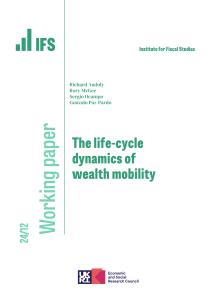The latest increase in the state pension age from 65 to 66 – which took place gradually between late 2018 and late 2020 – has significantly boosted the employment of both men and women, leading to 55,000 more 65-year-olds in paid work. Combined, 65-year-olds are working an additional 1.8 million hours per week due to this rise in the state pension age from 65 to 66.
But the effects were unequal. The reform led to an additional 7% of men and 9% of women staying in paid work at age 65. But in the most deprived fifth of areas, women’s employment rate at age 65 rose by 13 percentage points and men’s by 10 percentage points. In contrast, in the most prosperous areas, female and male employment rates at age 65 rose by just 4 and 5 percentage points respectively. This almost certainly reflects the greater need for income at older ages among those living in poorer areas.
Overall by mid 2021, the male employment rate at age 65 rose to 42% and the female rate to 31%. Both are the highest seen since at least the mid 1970s and, at least in the case of women, very likely to be the highest rate ever in the UK. The increase in employment among 65-year-olds due to the reform was as big as the increase that took twelve years between 2005 and 2017.
Nevertheless, it remains the case that more than 90% of 65-year-olds (around 640,000 of them) do not change whether they are in paid work at age 65 purely because of the higher state pension age. This is in large part because the majority of men and women have already left the labour market before their 65th birthday, while some others would have stayed in paid work even if the state pension age had remained at 65.
These are some of the key findings of new research published today by researchers at the Institute for Fiscal Studies, which has been funded by the Centre for Ageing Better. The research analyses how employment decisions have been affected by the increase in the state pension age to 66 and will, in particular, be crucial evidence for Baroness Neville-Rolfe as she conducts the second independent review of the state pension age for the Department for Work and Pensions.
Other key findings include:
- The increase in employment resulting from the higher state pension age is due to people staying in their current job for longer, rather than to those in work moving to a different employer or those not in paid work returning to the labour market. The increase in employment is predominantly due to increases in full-time work rather than part-time work.
- Most of those who decide to delay retirement as a result of the latest rise in the state pension age are actually likely to be financially better off as a result. They would only need to work around 20 hours a week at the National Living Wage to make up for the loss of state pension income, and most earn much more than this a week. However, they lose out on the leisure time and other potential benefits of retirement compared with being in work.
- In contrast, a group that face obvious difficulties as a result of the higher state pension age are those who are unemployed: instead of receiving a state pension (and potentially retiring), they are continuing to search for work and can only qualify for much less financial support from the working-age benefit system. We estimate that an additional 5,000 65-year-olds are unemployed and seeking work as a direct result of the increase in the state pension age from 65 to 66. In addition, 25,000 people report that they are out of work for long-term health reasons, rather than being retired, as a result of the state pension age rising from 65 to 66.
Laurence O’Brien, a Research Economist at IFS and an author of the report, said:
‘There have been striking increases in employment of 65-year-olds in recent years as the state pension age rose from 65 to 66. Indeed, employment rates for this age group have reached record highs. However, it is still the case that over 90% of people do not change their employment decision at age 65 purely as a result of the higher state pension age. This is mainly because most people have already left the labour force before turning 65. For most 65-year-olds – around 640,000 of them – a higher state pension age simply results in lower income rather than changing their work patterns.’
Jonathan Cribb, an Associate Director at IFS and another author of the report, said:
‘The sharp increases in employment have come in particular from those in poorer areas, and for those who have lower levels of education, suggesting that without a state pension they cannot afford to retire. But of the 55,000 extra 65-year-olds who are in employment, 35,000 are in full-time work even though only 20 hours of work each week at the National Living Wage would be sufficient for most to make up for the delay in the receipt of their state pension. Given that a quarter of people working full-time in their mid 60s want to work fewer hours, this suggests there may be an unmet desire for many approaching state pension age to be able to work part-time, or more flexibly, than they are currently doing. This large pool of untapped potential part-time employees could be an attractive source of labour to many employers.’
Emily Andrews, Deputy Director for Evidence at the Centre for Ageing Better (the funder of the research), said:
‘A significant proportion of workers are staying in work for an extra year at 65, until reaching the new state pension age of 66. They will be financially better off as a result, and this outcome shows that increasing the SPA is an effective policy for extending working lives among the employed.
‘But people who are not in work are in a much worse position. For the 5,000 65-year-olds who are now unemployed – or the 25,000 who cannot work due to their health – the policy means up to an extra year without the financial benefits of a salary or £9,000 in state pension. Indeed, the research shows that most 65-year-olds – 640,000 of them – are making no changes to their working patterns. For them, the policy change simply makes them financially worse off.
‘With the SPA set to rise further, the government must get serious about meaningful support to help workless people in their 60s get back into paid work. Otherwise, this policy will further harm those who are already disadvantaged by an ageist labour market. And now is clearly the time to consider seriously what further financial support should be offered to those for whom work simply is not an option.’











